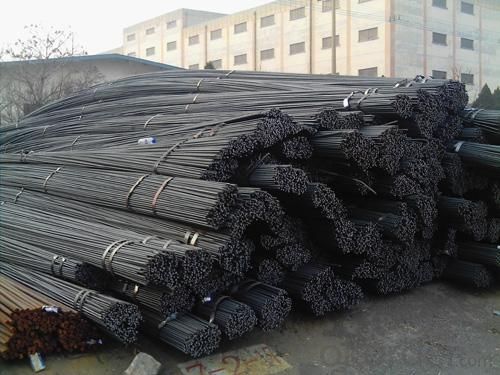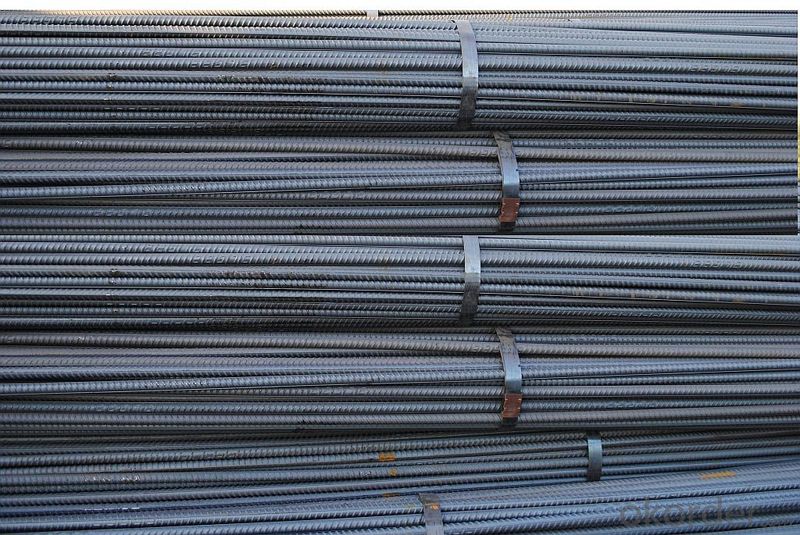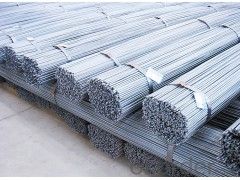GR60 deformed steel bars for construction
- Loading Port:
- Tianjin
- Payment Terms:
- TT or LC
- Min Order Qty:
- 25 m.t.
- Supply Capability:
- 100000 m.t./month
OKorder Service Pledge
OKorder Financial Service
You Might Also Like
Product Description:
OKorder is offering GR60 deformed steel bars for construction at great prices with worldwide shipping. Our supplier is a world-class manufacturer of steel, with our products utilized the world over. OKorder annually supplies products to European, North American and Asian markets. We provide quotations within 24 hours of receiving an inquiry and guarantee competitive prices.
Product Applications:
GR60 deformed steel bars for construction are ideal for structural applications and are widely used in the construction of buildings and bridges, and the manufacturing, petrochemical, and transportation industries.
Product Advantages:
OKorder's deformed steel bars are durable, strong, and resist corrosion.
Main Product Features:
· Premium quality
· Prompt delivery & seaworthy packing (30 days after receiving deposit)
· Corrosion resistance
· Can be recycled and reused
· Mill test certification
· Professional Service
· Competitive pricing
Product Specifications:
\Deformed bar is widely used in buildings, bridges, roads and other engineering construction. Big to highways, railways, bridges, culverts, tunnels, public facilities such as flood control, dam, small to housing construction, beam, column, wall and the foundation of the plate, deformed bar is an integral structure material. With the development of world economy and the vigorous development of infrastructure construction, real estate, the demand for deformed bar will be larger and larger..
Packaging & Delivery of HRB400 Deformed Steel Bar:
Packaging Detail: products are packed in bundle and then shipped by container or bulk vessel, deformed bar is usually naked strapping delivery, when storing, please pay attention to moisture proof. The performance of rust will produce adverse effect.
Each bundle weight: 2-3MT, or as required
Payment term: TT or L/C
Delivery Detail: within 45 days after received advanced payment or LC.
Label: to be specified by customer, generally, each bundle has 1-2 labels
Trade terms: FOB, CFR, CIF



FAQ:
Q1: Why buy Materials & Equipment from OKorder.com?
A1: All products offered byOKorder.com are carefully selected from China's most reliable manufacturing enterprises. Through its ISO certifications, OKorder.com adheres to the highest standards and a commitment to supply chain safety and customer satisfaction.
Q2: Can stainless steel rust?
A2: Stainless does not "rust" as you think of regular steel rusting with a red oxide on the surface that flakes off. If you see red rust it is probably due to some iron particles that have contaminated the surface of the stainless steel and it is these iron particles that are rusting. Look at the source of the rusting and see if you can remove it from the surface.
- Q:Are there any health and safety concerns related to steel rebars?
- Yes, there are several health and safety concerns related to steel rebars. Firstly, handling and lifting steel rebars can pose risks of musculoskeletal injuries such as strains, sprains, and back injuries. These rebars are heavy and often require manual handling or the use of heavy machinery, which can increase the risk of accidents and injuries. Secondly, steel rebars are often coated with chemicals to prevent corrosion. These coatings can contain hazardous substances such as toxic metals or volatile organic compounds (VOCs). Exposure to these chemicals through inhaling fumes or direct contact with the skin can lead to health issues, including respiratory problems, skin irritation, and chemical burns. Furthermore, steel rebars are commonly used in construction sites, which can be hazardous environments. Workers may face risks of falling rebars, tripping over them, or being struck by them. Additionally, improper installation or positioning of steel rebars can compromise the structural integrity of the construction, potentially leading to accidents or collapses. To mitigate these health and safety concerns, it is important to provide appropriate training and personal protective equipment (PPE) to workers handling steel rebars. Employers should also enforce proper lifting techniques and safe work practices to prevent musculoskeletal injuries. Adequate ventilation systems and the use of respiratory protection can help in reducing exposure to hazardous chemicals. Lastly, regular inspections and adherence to construction regulations can ensure the proper placement and installation of steel rebars, minimizing the risk of accidents and structural failures.
- Q:How do steel rebars contribute to the overall ductility of a structure?
- Steel rebars contribute to the overall ductility of a structure in several ways. Firstly, steel rebars are highly flexible and can withstand a significant amount of stress before yielding or breaking. This flexibility allows them to absorb and distribute the applied load, reducing the chances of sudden failure or collapse. By providing additional reinforcement to the concrete, rebars help the structure withstand external forces such as earthquakes or extreme weather conditions. Secondly, rebars increase the tensile strength of the concrete. Concrete is known for its high compressive strength but has relatively low tensile strength. When stress is applied to a structure, the rebars help to resist the tension forces and prevent cracking or failure. This ensures that the structure can withstand both compressive and tensile forces, enhancing its overall durability and safety. Moreover, steel rebars also enhance the structural integrity by preventing the propagation of cracks. When a crack starts to form in a concrete element, the rebars act as a barrier, limiting the crack's expansion and preventing it from spreading rapidly. This characteristic of rebars helps to maintain the overall stability and integrity of the structure. In addition, steel rebars provide a higher degree of flexibility during construction. They can be easily bent, shaped, and joined to meet specific design requirements, allowing architects and engineers to create structures that are more aesthetically pleasing and functional. This flexibility also facilitates the construction process by allowing for modifications or adjustments to be made without compromising the overall strength or stability of the structure. Overall, steel rebars play a crucial role in enhancing the ductility of a structure. They increase the tensile strength, absorb and distribute stress, prevent crack propagation, and provide flexibility during construction. These properties contribute to the overall durability, safety, and structural integrity of a building or infrastructure, making steel rebars an essential component in modern construction practices.
- Q:What grade of reinforcement is used for cast-in-place floorslab?
- Now the more commonly used high-rise buildings are cast-in-place floorslab.The floor slab, of course, separates the floor and bears and transmits the floor load. At the same time, heat insulation, sound insulation, waterproof and so on.
- Q:Can steel rebars be used in structures with limited construction regulations?
- Steel rebars can be used in structures with limited construction regulations, but it is important to note that the safety and structural integrity of the building may be compromised without proper regulations. Steel rebars are commonly used as reinforcement in concrete structures to provide strength and stability. However, the use of rebars alone does not guarantee the safety of a structure. Construction regulations exist to ensure that buildings are designed and constructed to withstand various forces and loads, such as wind, earthquakes, and live loads. These regulations also cover aspects such as fire safety, electrical systems, and accessibility. Without these regulations, there is a higher risk of structural failure or other safety issues. Using steel rebars in structures without proper construction regulations may result in buildings that are not adequately designed or constructed to withstand these forces and loads. This can lead to structural failure, collapse, or other hazards. It is therefore advisable to adhere to local construction codes and regulations to ensure the safety and longevity of any structure.
- Q:How are steel rebars cut and bent on-site?
- Specialized tools and equipment are utilized on-site to cut and bend steel rebars. The process typically consists of the following steps: 1. Measurement: The rebars are measured according to the specified length and dimensions in the construction plans. This step is crucial to ensure precise and accurate cutting and bending. 2. Cutting: Various tools, such as manual rebar cutters, hydraulic shears, or portable electric cutters, are employed to cut the rebars. These tools are designed to make clean and precise cuts without damaging the rebars. The rebars are securely positioned, and the cutting tool is applied to the marked area to achieve the desired length. 3. Bending: Once the rebars are cut to the required length, they are bent using rebar benders. These machines possess different attachments and rollers to shape the rebars into the desired angle and radius. The rebars are cautiously positioned and secured in the bender, and the machine exerts force to bend them according to the specified shape. 4. Quality control: Following the cutting and bending stages, quality control checks are conducted to ensure that the rebars meet the required specifications. This may include visual inspections, measurements, and testing to verify the accuracy of dimensions and the quality of cuts and bends. It is important to note that skilled workers, such as ironworkers or steel fixers, typically assume responsibility for on-site rebar cutting and bending. They possess the expertise to interpret construction plans, utilize the appropriate tools, and guarantee the accurate cutting and bending of rebars to meet the project's requirements.
- Q:Are steel rebars suitable for use in structures with high wind loads?
- Structures with high wind loads can benefit from the use of steel rebars. Also known as reinforcing bars, steel rebars are commonly utilized in construction to provide strength and stability to reinforced concrete structures. Their purpose is to withstand significant tensile forces and play a crucial role in maintaining the structural integrity of buildings, particularly in areas prone to high wind loads. Steel rebars possess several advantages that render them suitable for structures with high wind loads. Firstly, steel exhibits exceptional tensile strength, enabling it to resist the forces generated by wind loads. Unlike materials such as timber or concrete, steel rebars possess remarkable ductility, allowing them to absorb and redistribute the energy produced by wind-induced vibrations. Secondly, steel rebars demonstrate remarkable durability and resistance to corrosion. This characteristic is vital for structures exposed to harsh weather conditions, including strong winds. Utilizing steel rebars mitigates the risk of structural deterioration or weakening over time caused by wind-induced stresses. Furthermore, steel rebars offer ease in molding and shaping, accommodating the specific design requirements of the structure. This flexibility empowers engineers to create and construct buildings capable of withstanding various wind loads experienced in different regions. In conclusion, due to their high tensile strength, durability, and resistance to corrosion, steel rebars are an ideal choice for structures with high wind loads. They provide the necessary reinforcement to ensure the longevity and safety of the structure under challenging wind conditions.
- Q:What are the guidelines for installing steel rebars in concrete columns?
- The guidelines for installing steel rebars in concrete columns involve several important considerations to ensure the structural integrity and durability of the columns. 1. Reinforcement design: The first step is to have a proper reinforcement design that specifies the size, length, and spacing of the rebars. This design should be prepared by a qualified engineer or consultant, taking into account the column's load-bearing requirements and the structural design standards. 2. Rebar preparation: Before installation, the steel rebars should be thoroughly cleaned to remove any rust, oil, or other contaminants that may hinder the bond between the rebar and the concrete. Additionally, the ends of the rebars should be properly cut and bent as specified in the reinforcement design. 3. Placement: The rebars should be placed accurately as per the reinforcement design. They should be positioned in the center of the column and secured to maintain the required spacing and alignment. The rebars should not touch the formwork or be placed too close to the edges of the column. 4. Splicing: When the height of the column exceeds the length of the rebar, splicing is necessary. Rebar splicing should be done according to the approved methods, such as lap splicing, mechanical couplers, or welded splices. The spliced rebars should have sufficient overlap length and provide a continuous load path. 5. Tying: Proper tying of the rebars is crucial to maintain their position during the concrete pouring. The rebars should be tied securely at the intersections using binding wire or other approved tying methods. The ties should be tight enough to prevent displacement but not too tight to damage the rebars. 6. Concrete pouring: Once the rebars are installed, the concrete is poured into the formwork, surrounding the rebars completely. Care should be taken to avoid segregation or honeycombing in the concrete, which can compromise the bond between the rebars and the concrete. 7. Concrete cover: The reinforcement design will specify the required concrete cover over the rebars. This cover protects the rebars from corrosion and provides fire resistance. It is crucial to maintain the specified concrete cover throughout the column's height and ensure it is not compromised during construction. 8. Quality control: Regular inspections and quality control measures should be implemented during the installation process. This includes checking the reinforcement alignment, spacing, and cover, as well as verifying the use of proper tying methods and splicing techniques. By following these guidelines, the installation of steel rebars in concrete columns can be carried out effectively, ensuring the structural strength and durability of the columns. It is essential to adhere to the local building codes and standards, as well as seek professional advice if needed, to ensure the proper installation of rebars in concrete columns.
- Q:Can steel rebars be used in structures with high seismic activity?
- Yes, steel rebars can be used in structures with high seismic activity. Steel is a resilient material that can withstand the forces generated during earthquakes. By reinforcing the concrete with steel rebars, the structure gains additional strength and enhances its ability to resist seismic forces. The use of steel rebars helps to improve the overall structural integrity and safety of the building in areas prone to earthquakes.
- Q:Are steel rebars suitable for use in high-rise buildings?
- Yes, high-rise buildings can use steel rebars as they are suitable for this purpose. Steel rebars, also known as reinforcing bars, are commonly utilized in the construction industry to provide strength and stability to concrete structures. In order to withstand various loads and forces like wind, earthquakes, and the weight of the building itself, high-rise buildings require a robust and resilient structural system. Steel rebars possess exceptional tensile strength and ductility, making them an ideal choice for reinforcing concrete in such structures. One of the primary advantages of steel rebars is their ability to resist tensile forces. While concrete is strong in compression, it is weak in tension. Steel rebars help overcome this weakness by providing the necessary tensile strength. This is particularly important in high-rise buildings where the weight of the structure can induce tension on the concrete components. By reinforcing the concrete with steel rebars, the overall structural integrity of the building is enhanced, ensuring its safety and stability. Furthermore, steel rebars exhibit superior ductility, meaning they can deform under stress without fracturing. This property is crucial in high-rise buildings as they are subjected to dynamic loads and potential movements caused by factors like wind or seismic activity. Steel rebars can absorb and distribute these forces, minimizing the risk of structural failure or collapse. Moreover, steel rebars are readily available and cost-effective compared to alternative materials such as carbon fiber or fiberglass. They can be easily fabricated and installed in various shapes and sizes to meet the specific design requirements of high-rise buildings. However, it is important to note that the suitability of steel rebars in high-rise buildings also relies on proper design, installation, and regular maintenance. It is crucial to adhere to the relevant building codes and standards, ensure adequate corrosion protection, and conduct regular inspections to identify any potential issues. By following these practices, steel rebars can provide a dependable and long-lasting reinforcement solution for high-rise buildings.
- Q:Can steel rebars be used in both residential and commercial construction?
- Yes, steel rebars can be used in both residential and commercial construction. Steel rebars are commonly used as reinforcement in concrete structures to provide added strength and durability. They are suitable for a wide range of applications, including foundations, walls, columns, beams, and slabs, which are common elements in both residential and commercial construction. The use of steel rebars ensures that the concrete structures can withstand the loads and stresses imposed on them, making them suitable for various construction projects, regardless of their scale or purpose.
1. Manufacturer Overview |
|
|---|---|
| Location | |
| Year Established | |
| Annual Output Value | |
| Main Markets | |
| Company Certifications | |
2. Manufacturer Certificates |
|
|---|---|
| a) Certification Name | |
| Range | |
| Reference | |
| Validity Period | |
3. Manufacturer Capability |
|
|---|---|
| a)Trade Capacity | |
| Nearest Port | |
| Export Percentage | |
| No.of Employees in Trade Department | |
| Language Spoken: | |
| b)Factory Information | |
| Factory Size: | |
| No. of Production Lines | |
| Contract Manufacturing | |
| Product Price Range | |
Send your message to us
GR60 deformed steel bars for construction
- Loading Port:
- Tianjin
- Payment Terms:
- TT or LC
- Min Order Qty:
- 25 m.t.
- Supply Capability:
- 100000 m.t./month
OKorder Service Pledge
OKorder Financial Service
Similar products
New products
Hot products
Related keywords




























